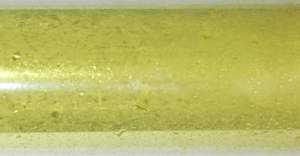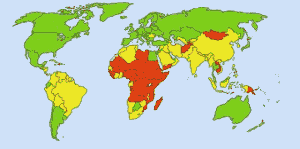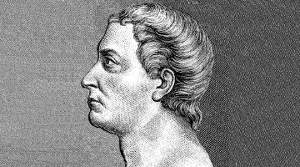The chemical element chlorine is classed as halogen and a nonmetal. It was discovered in 1774 by Carl Wilhelm Scheele.

Data Zone
| Classification: | Chlorine is a halogen and a nonmetal |
| Color: | greenish-yellow |
| Atomic weight: | 35.453 |
| State: | gas |
| Melting point: | -101 oC , 172 K |
| Boiling point: | -34 oC , 239 K |
| Electrons: | 17 |
| Protons: | 17 |
| Neutrons in most abundant isotope: | 18 |
| Electron shells: | 2,8,7 |
| Electron configuration: | 1s2 2s2 2p6 3s2 3p5 |
| Density @ 20oC: | 0.003214 g/cm3 |
Compounds, Radii, Conductivities
| Atomic volume: | 22.7 cm3/mol |
| Structure: | layers of Cl2 in solid |
| Hardness: | |
| Specific heat capacity | 0.48 J g-1 K-1 |
| Heat of fusion | 6.406 kJ mol-1 of Cl2 |
| Heat of atomization | 122 kJ mol-1 |
| Heat of vaporization | 20.41 kJ mol-1 of Cl2 |
| 1st ionization energy | 1251.1 kJ mol-1 |
| 2nd ionization energy | 2297.3 kJ mol-1 |
| 3rd ionization energy | 3821.8 kJ mol-1 |
| Electron affinity | 349 kJ mol-1 |
| Minimum oxidation number | -1 |
| Min. common oxidation no. | -1 |
| Maximum oxidation number | 7 |
| Max. common oxidation no. | 7 |
| Electronegativity (Pauling Scale) | 3.16 |
| Polarizability volume | 2.2 Å3 |
| Reaction with air | none |
| Reaction with 15 M HNO3 | mild, ⇒ HClOx, NOxCl, NOx |
| Reaction with 6 M HCl | mild, ⇒ HOCl, Cl– |
| Reaction with 6 M NaOH | mild, ⇒ OCl–, Cl– |
| Oxide(s) | Cl2O, ClO2, Cl2O7 |
| Hydride(s) | HCl |
| Chloride(s) | Cl2 |
| Atomic radius | 100 pm |
| Ionic radius (1+ ion) | – |
| Ionic radius (2+ ion) | – |
| Ionic radius (3+ ion) | – |
| Ionic radius (1- ion) | 167 pm |
| Ionic radius (2- ion) | – |
| Ionic radius (3- ion) | – |
| Thermal conductivity | 0.0089 W m-1 K-1 |
| Electrical conductivity | – |
| Freezing/Melting point: | -101 oC , 172 K |

Chlorine In Test Tube (Photo: Ben Mills)

Safe Drinking Water: Image: Ionut_Cojocaru. In green areas everyone can get safe water. In red areas, at least 25 percent of people can’t get treated water. Yellow areas are intermediate. Before the routine use of chlorine in U.S. water supplies, typhoid fever claimed 25 000 fatalities each year. Today 98% of public water supplies are treated with chlorine or a chlorine compound. Typhoid fever now claims about one victim a year, on average. (4)

Carl Wilhelm Scheele, who discovered chlorine in 1774.
Discovery of Chlorine
Chlorine was first produced in 1774 by Carl Wilhelm Scheele in Sweden. Scheele collected the gas released by the reaction of pyrolusite [manganese dioxide] with spiritus salis – an alchemical term meaning spirit/breath of salt. [It was also known as muriatic acid and we now call it hydrochloric acid.] The new gas had, according to Scheele, “a very perceptible suffocating smell, which was most oppressive to the lungs… and gives the water a slightly acidic taste… the air in it acquires a yellow color…” (1)
Scheele also noted the high reactivity and the bleaching qualities of the new gas he had made: “…all metals were attacked… fixed alkali was converted into common salt… all vegetable flowers – red, blue, and yellow – became white in a short time; the same thing also happened with green plants… insects immediately died. (1)
Despite the accuracy of his observations, Scheele mistakenly thought the new gas was a dephlostiganated [* see below] form of muriatic acid.
The famous French chemist Antoine Lavoisier believed the new gas should be called oxymuriatic acid [an oxide of hydrochloric acid] based on the as yet undiscovered element murium. (2)
* The confusion about chlorine’s true identity was caused by the phlogiston theory; phlogiston had been accepted by chemists for most of the 1700s – until Lavoisier himself debunked it. Phlogiston was a ‘substance’ used to explain the then inexplicable. Conveniently, it had negative weight when it needed to, and ‘explained’ reactions such as rusting and burning.
Lavoisier was the architect of phlogiston’s downfall, showing that the chemistry of oxygen was a better explanation in chemical reactions than phlogiston was. (3)
By 1810 the scientific consensus was that the element we now call chlorine was actually a compound that contained oxygen. English chemist Sir Humphry Davy found that the consensus was wrong; he could not get the new yellow-green gas to react with a charcoal electrode, which made him believe it may not contain oxygen. In reactions with phosphorus and ammonia, he demonstrated the new gas did not contain oxygen. He used a huge, 2000 plate voltaic pile [battery] to see whether he could extract oxygen from the gas’s phosphorus and sulfur compounds, but again he found no oxygen. (1a)
In 1811, Davy concluded the new gas was in fact a new element. (1b) He named it chlorine, from the Greek word ‘chloros,’ meaning pale green or yellow-green.
Interesting Facts about Chlorine
- The first chain reaction discovered was not a nuclear reaction; it was a chemical chain reaction. It was discovered in 1913 by Max Bodenstein, who saw a mixture of chlorine and hydrogen gases explode when triggered by light. The chain reaction mechanism was fully explained in 1918 by Walther Nernst.
- Earth’s oceans contain a large amount of chlorine. If this chlorine were released as a gas, its weight would be 5x greater than Earth’s total current atmosphere. (Our oceans contain about 2.6 x 1016 metric tons of chlorine, mostly as sodium chloride.)
- Chlorine is not only abundant in our oceans; it is the sixth most abundant element in Earth’s crust.
- Exposure to small amounts of chlorine, even for a short time, can be deadly. Fatalities are expected at 1 part in a thousand chlorine in air (or sometimes at even lower concentrations). (5)
- Chlorine is heavier than air. When released, it forms a poisonous blanket that drifts along with the wind. Chlorine was used as a chemical weapon in World War I, first in 1915 by the German army and then by the Western Allies. It was not as ‘effective’ as had been hoped, because chlorine is easily detected by its strong smell. It is also water soluble, and so soldiers could protect themselves from the worst of its effects by breathing through damp cloths.

Appearance and Characteristics
Harmful effects:
Chlorine is a toxic gas that irritates the skin, the eyes and the respiratory system.
Characteristics:
Chlorine is a greenish-yellow, diatomic, dense gas with a sharp smell (the smell of bleach).
It is not found free in nature as it combines readily with nearly all other elements.
Chlorine occurs in nature mainly as common salt (NaCl), carnallite [ KMgCl2.6(H20) ], and sylvite (KCl).
In its liquid and solid form it is a powerful bleaching, oxidizing and disinfecting agent.
Uses of Chlorine
Chlorine is used for producing safe drinking water.
Chlorinated compounds are used mostly for sanitation, pulp bleaching, disinfectants, and textile processing.
Chlorine is also used for the manufacture of chlorates and it is important in organic chemistry, forming compounds such as chloroform, carbon tetrachloride, polyvinyl chloride, and synthetic rubber.
Other uses of chlorine compounds include dyestuffs, petroleum products, medicines, antiseptics, insecticides, foodstuffs, solvents, paints and plastics.
Abundance and Isotopes
Abundance earth’s crust: 145 parts per million by weight, 85 parts per million by moles
Abundance solar system: 8 parts per million by weight, 0.3 parts per million by moles
Cost, pure: $0.15 per 100g
Cost, bulk: $ per 100g
Source: Chlorine gas is produced commercially by the electrolysis of sodium chloride (NaCl) from seawater or brine from salt mines.
Isotopes: Chlorine has 16 isotopes whose half-lives are known, with mass numbers 31 to 46. Naturally occurring chlorine is a mixture of its two stable isotopes 35Cl and 37Cl with natural abundances of 75.8% and 24.3% respectively.

References
- Henry M. Leicester, Herbert S. Klickstein, A Source Book in Chemistry, 1400-1900., (1969) Harvard University Press. p111; 1a. p241.; 1b. p257.
- J.W. Mellor, A Comprehensive Treatise on Inorganic and Theoretical Chemistry., 1922, vol 2, Longmans, Green and Co., p21.
- Antoine Lavoisier, Memoires de l’ Academie royale des sciences 1783., 1786, p505-538.
- The Chlorine Tree.
- OSHA, Occupational Safety and Health Guideline for Chlorine.
Cite this Page
For online linking, please copy and paste one of the following:
<a href="https://www.chemicool.com/elements/chlorine.html">Chlorine</a>
or
<a href="https://www.chemicool.com/elements/chlorine.html">Chlorine Element Facts</a>
To cite this page in an academic document, please use the following MLA compliant citation:
"Chlorine." Chemicool Periodic Table. Chemicool.com. 16 Oct. 2012. Web. <https://www.chemicool.com/elements/chlorine.html>.
very impressive content…
nice web site…
I’m having a question: though chlorine is poisonous, why it is used to produce safe drinking water???
It depends on the concentration. In high concentrations chlorine can kill us. When the concentrations are low it kills bugs but leaves us unharmed.
Over time would the low concentration of chlorine have affects on us?
I have chlorine for a project in science but i dont know any MINDBLOWING facts. Help?
Chlorine atoms can eat up the earths ozone layer without being destroyed.
I love this site we are doing a class periodic table and everyone in the class got there own element and we are doing research about it and this site gave me a lot of the information i needed
what are some elements similar to Chlorine?